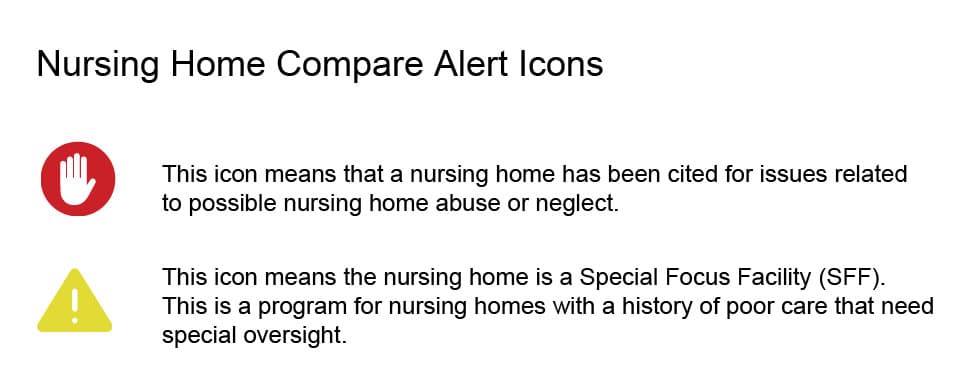Nursing Home Compare Now Includes Icons

Finding the right nursing home for a loved one is a difficult task. Families spend a great deal of time, effort, and money researching homes and making a decision. This process can be overwhelming as you consider factors like quality, safety, abuse, neglect, and your loved one’s legal rights.
Now, the Centers for Medicare and Medicaid Services (CMS) wants to make this process a bit easier. CMS is now using icons on their website to help users identify problems with prospective nursing homes. The icons will appear next to the names of nursing homes on the Compare website. Website users can identify the icons as the following:

By including these icons, CMS hopes that users on their website will feel more informed about the facilities they are considering. Rather than wondering if the facility has recently been cited, users can readily see which ones have.
More Information about Nursing Home Compare Icons
The nursing home compare website is a tool for families to locate nursing homes and find information about how they are operated, managed, and rated after inspections. The goal of the new CMS icons is to alert families to potential problems, now or in the past. That way, families have as much information as possible before they make a decision.
Red Icon: Recently Cited for Abuse or Neglect
The red icon next to a nursing home indicates that a nursing home has recently been cited for possible abuse or neglect. CMS defines abuse as “the willful infliction of injury, unreasonable confinement, intimidation, or punishment with resulting physical harm, pain or mental anguish. It includes verbal abuse, sexual abuse, physical abuse, and mental abuse.”
The red icon will appear next to facilities cited for abuse that caused harm to a resident within the last year. Also, the icon will appear next to facilities cited for abuse that could potentially cause harm to a resident within the last two years.
Nursing homes that are cited for abuse are required to complete certain steps in order to protect residents. By identifying a facility that has recently been cited, families can explore what the facility is doing now to protect residents and prevent future instances of abuse.
Yellow Icon: Special Focus Facility
The yellow icon next to a nursing home indicates that it is a Special Focus Facility (SFF). These are nursing homes that have a history of quality issues or are participating in a special program to increase quality of care.
During CMS inspections, if a nursing home does not meet quality and safety standards, it is cited as deficient and is given a list of actions to correct. Some nursing homes have problems outside of what CMS considers normal or average. These facilities are those with:
- More problems than other facilities (twice the number of deficiencies during an inspection)
- The problems identified are more serious (including injury or harm to residents)
- There is a pattern of serious problems that persists over a period of time (CMS measures the previous three years)
CMS considers SFF nursing homes to be something of a “yo-yo” or “in and out” of compliance. There are generally repeated issues and cycles of deficiencies.
Under the SFF program, the facility becomes subject to full onsite inspections every six months and progressive enforcement of quality and safety standards. This continues until the facility is eligible to graduate from the program, or CMS terminates them from their programs. Around 10 percent of SFF nursing homes are terminated.
Tips for Choosing a Nursing Home
Once you identify a few facilities that might work for your family, the next step is making a choice. CMS offers some tips for narrowing down and choosing a nursing home. Consider the following:
- Get information about prospective nursing homes in your area:
- Ask friends, neighbors, or colleagues if they have experience with local nursing homes.
- Ask your healthcare provider if he or she offers care at local facilities.
- Contact local senior center or community center to find out how active the senior community is.
- Use Medicare’s Nursing Home Compare tool to find out more about the quality and safety of prospective nursing homes.
- Visit each prospective nursing home and take note of important factors, such as:
- How does the facility look, feel, and smell?
- Is the facility clean and well maintained?
- Are residents out and about? Do they seem happy and well cared for?
- What sort of common areas or activity spaces are available to residents?
- What sort of private areas are available?
- Does the facility offer services for recreation, socializing, religion, or cultural activities?
- Does the facility offer transportation?
- Are there doctors or nurses on staff? Who are they? What are their credentials?
- What is the staff-to-resident ratio on a given day? How is staffing on weekends?
- What are the responsibilities of staff members, residents, and family members?
- Does the facility offer prepared meals? Is there a public dining area? Ask to see a menu while you are there.
- Does the facility offer care for residents with dementia?
- Make sure that your short list facilities have beds available.
- Select the nursing home that is the best fit for your loved one’s needs and budget.
What Happens after Choosing a Nursing Home?
After choosing the nursing home you feel is best for your loved one, your next step will be making sure that he or she settles in well. Be active during the moving process and make the experience as enjoyable as possible. Be present at the nursing home while your loved one settles in. If you or your loved one has questions, never hesitate to ask.
Remember, if at any time you feel that your loved one is not being properly cared for, you have options to address concerns and investigate the situation. Nursing home residents do not have to settle for care or treatment that is subpar. If you notice any sign of abuse or neglect, take it seriously and act quickly.
Speak with a supervisor or administrator at the facility about your concerns. If their response is not adequate, you can always contact the local Office of the Ombudsman, Adult Protective Services, or Protection and Advocacy Agency in your area.
Nursing Home Abuse Center is Here to Help
If you have questions or concerns about nursing home abuse and neglect, you can also count on Nursing Home Abuse Center. We are here to help families understand that nursing home residents have legal rights and should never settle for poor quality care, abuse, or neglect. To find out more, contact us at 1-800-516-4783.
Sources:


